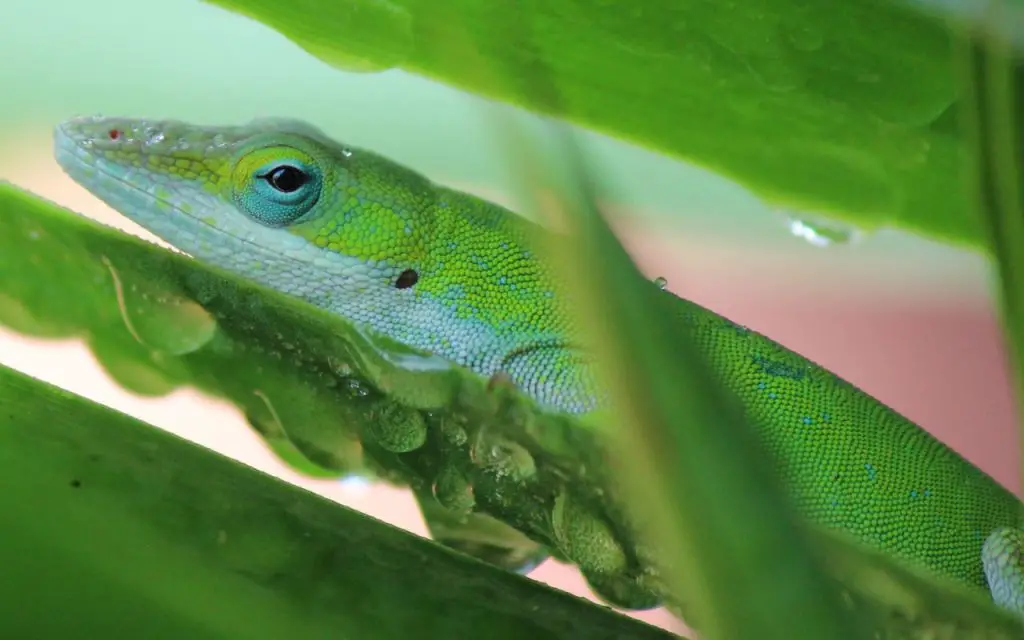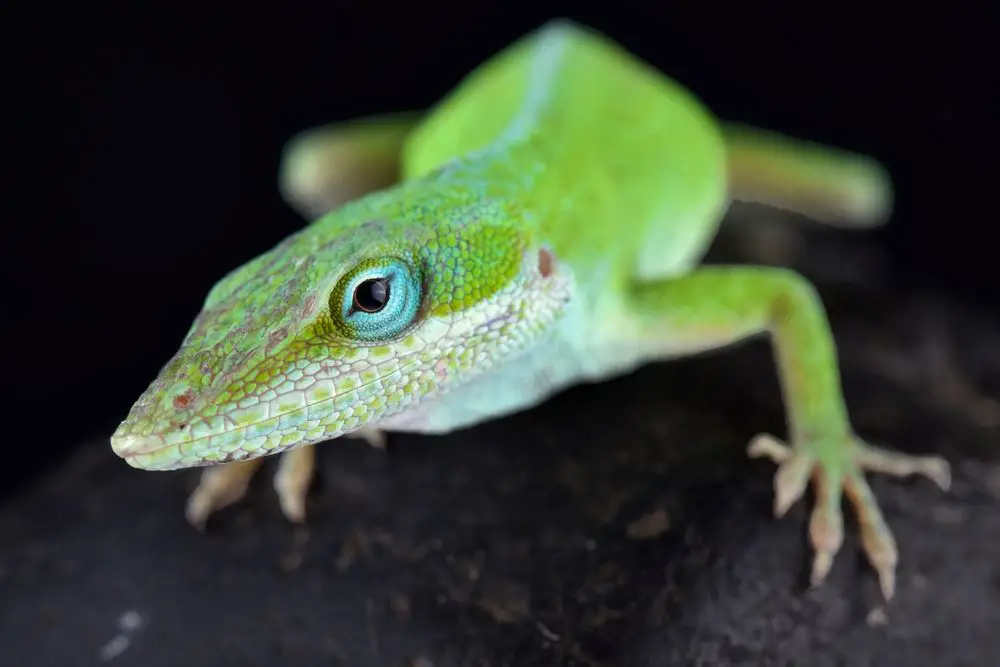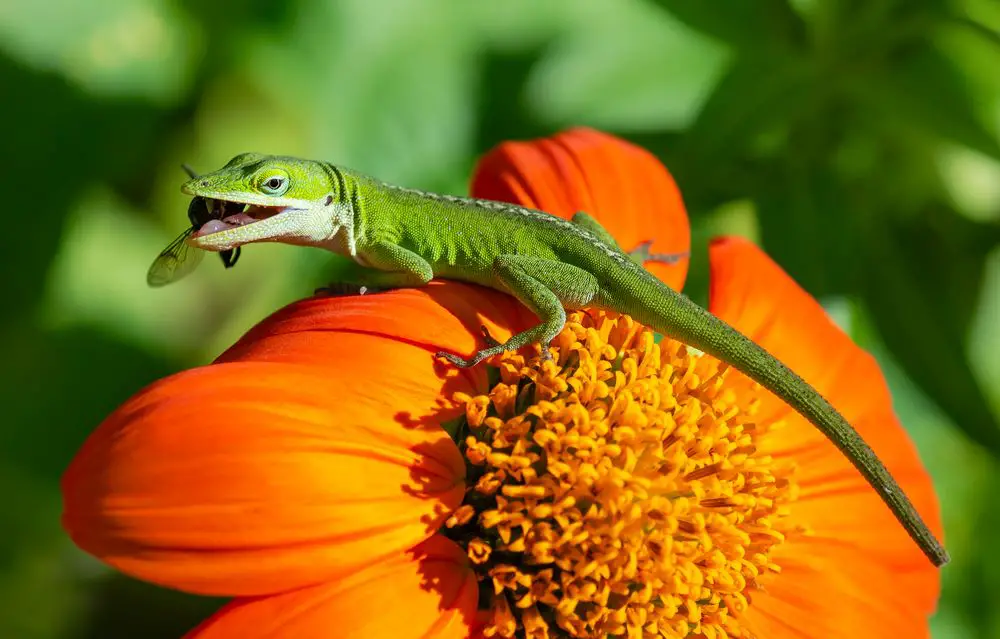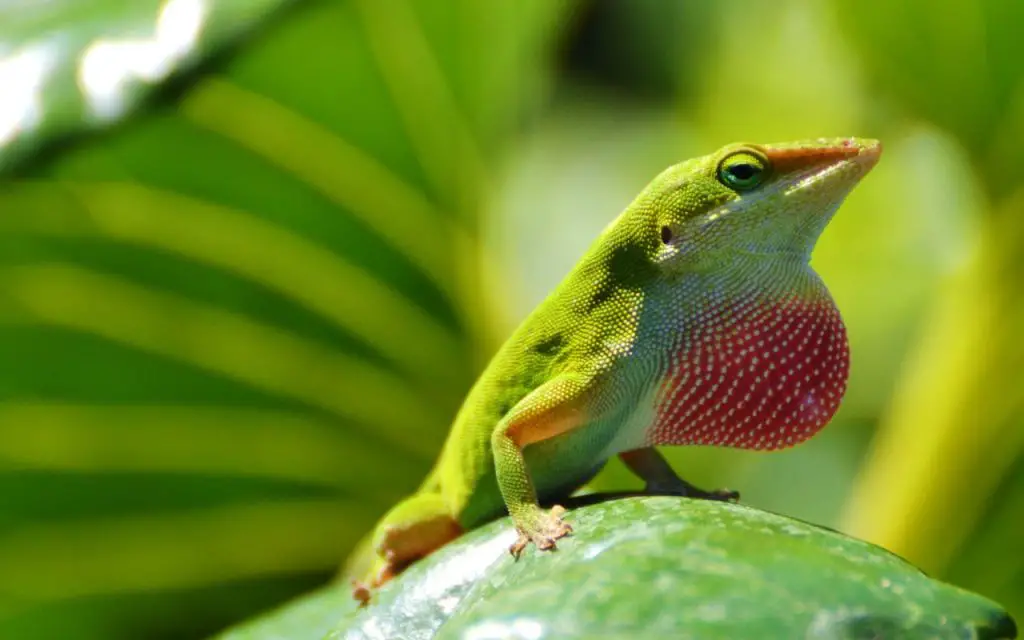Green Anoles mate in a way that essentially looks like crossing their tails. The complicated parts are the territorial and mating displays that occur first…
Last updated on February 1st, 2023 at 09:22 am
Green anoles mate seasonally and are polygynous. At the onset of the breeding season, males start displaying a distinctive set of sexual behaviors. The male anole will bob or bounce his head during a courtship meeting and extend his dewlap, a vivid red-throat fan. This display also serves to warn off rivals.
If the male and the female are able to successfully court, he will mate by introducing one of his 2 bilateral hemipenes. The female will then store the sperm, and use it for the duration of the breeding season.
Green anole behavior
Green anoles are typically shy and skittish creatures that do not prefer much handling. Anoles are small, active, and pleasant enough lizards that move swiftly, making them difficult to catch.
They can be housed either in little groups or alone. But the behavior of males may become aggressive in an attempt to defend their territory if two male anoles are housed in the same enclosure.
The most common aggressive behavior is opening and closing its dewlap. If you don’t separate them, fights can occur.

How long after mating do green anoles lay eggs?
The female begins to lay her first batch of eggs 2 to 4 weeks after mating, usually with one, or occasionally two eggs. The gestation periods vary greatly and can even last between five and seven weeks.
During the mating season, she can lay one egg every 7 to 10 days up until she has laid roughly 14 to 18 eggs. Some females will lay more or less depending on the weather that year. A female can lay eggs throughout summer long and still have some sperm left over for the subsequent breeding season with just one mating.

Green anole weight
An adult green anole typically weighs 2 to 6 g. Adult males are bigger than females and they may weigh anywhere between 3 and 7g. Each anole hatchling can weigh around 0.27 g.
Do anoles have a mating season?
Green anoles have a yearly mating season that ranges between four and five months typically from April until August. Since larger female and male sexual structures (ovaries and testes respectively) are developed at elevated temperatures, warmer weather has the biggest rate of reproduction.
The female anoles have an ovulation cycle that typically lasts around two weeks. The time between mating periods is determined by the length of this cycle.

Where do green anoles lay their eggs?
After the mating process, the female anole will search for a suitable location to lay the eggs. The eggs are soft-shelled and the females generally prefer to deposit the eggs in wet soil. They dig a shallow hole and lays the eggs in it.
This hole can be made in soft ground, rotting wood, compost, or leaf litter. They may sometimes place the eggs even in nearby tree holes. In enclosures, the females may also place their eggs in shallow scrape nests in debris or dirt at the foot of a plant.

How hard is it to breed green anoles?
Although green anoles can be easily mated and females produce fertile eggs, it can be exceedingly challenging to maintain the young alive until they are able to care for themselves. This is why very few people can successfully breed a new generation from their anole lizards.
These creatures do show a willingness to procreate in captivity when they are given the proper conditions. The breeding success depends heavily on the health of the anoles and on the condition of their surroundings.
The anoles should be well-fed and kept away from unfavorable conditions. Otherwise, they may react by ceasing non-essential functions like reproduction. Green Anoles cannot reproduce when fed just mealworms and crickets and maintained in barren, constrained terrariums.
Although it is possible for anoles to breed spontaneously, it is more probable if they are exposed to cyclical fluctuations in temperature, humidity, and light that replicate natural seasonal fluctuations. True hibernation is not necessary for anoles to facilitate breeding.
It is advisable to keep the daytime temperatures between 81 and 83 F throughout the cooling-off phase. But the nighttime temperature should be around 62 and 68 F. The daylight cycle should be progressively brought down to 8 to 10 hours. Anoles should also be well-hydrated to breed properly.
The daylight, humidity, and temperature should then be progressively increased after 6 to 8 weeks. They should also be fed a variety of food items like little roaches, caterpillars, silkworms, leafhoppers, beetles, moths, and earwigs.

Green anole adaptations
Green anoles show numerous physical and behavioral adaptations during their lifetimes. The motivation for these adaptations can range from a bid to show dominance to escaping from predators.
1. Physical adaptations
Physical adaptation is typically the anole changing its color. This is basically done for two purposes:
- Green anoles change color depending on the condition of their surroundings like temperature, stress, and humidity using unique structures under their skin. They generally turn brown when they are stressed, frightened, or even when they feel cold. They can turn back to their vivid green color when the stressing external factor is removed.
- Green anoles also resort to physical adaptations to escape from predators. This process called camouflage helps them to blend in with the surrounding environment easily confusing the predators. They can also climb and descend along vertical walls or surfaces due to the sticky tape-like features on the foot pads.
2. Behavioral adaptations
The behavioral adaptations in males are generally to show dominance in their territory. They are territorial creatures and exclusively hunt in their own territory. The behavioral adaptation a male anole shows when asserting dominance is to bob his head up and down, make a push-up kind of motion, and flare his pink dewlap.
They live in the Southeastern US, so if you live there you may be able to observe some of these behaviors yourself.
3. Adaptations they don’t have – but lots of people think they have!
A patagium.
This is a membrane that allows some animals, like the famous Draco lizards, to glide from tree to tree. Green Anoles do not have a patagium – if you read something that says they do, it’s a great clue that the website is written by someone who has no first-hand experience with the species!
The reason Green Anoles have recently been mislabelled gliders is that one of their relatives does in fact glide. The species in question is Anolis pentaprion, a twig anole from central America. This species is pretty good at gliding and does it when it needs to escape predators, or simply can’t be bothered climbing half-way down a huge tree.
Nonetheless, even Anolis pentaprion doesn’t have a patagium! It’s just really light, so it can glide by flattening itself out and steering with its feet.

How do green anoles give birth?
The reproduction process of anoles starts with the mating between the female and male. Soon after mating, the female begins to develop thick-shelled, tiny, eliptical, white eggs.
One egg is produced in turn by each ovary. After the egg is laid in the appropriate nesting site, the female anole does not take care of or remain near the egg until it hatches. The young green anoles consume small insects including fruit flies, houseflies, termites, and grubs to survive.
Green anoles for sale
Green anoles are a great reptilian pet option for people who are beginner pet owners. They are available in different online and offline pet stores that sell reptilian pets. They are generally available for less than $10 each. The sale may also be subjected to different state and local regulations.
That said, don’t let the cheap price fool you. The setup for a Green Anole will cost you much more than the animal. They need UVB lighting and a warm basking spot (you can usually achieve this with a mercury vapor bulb).
They also need a vertical enclosure, that gives them at least 24inches of climbing space, and ample hiding places. You should expect to spend at least $150-250 (£120-200) on their setup.
What does it look like when anoles mate?
Anoles are generally polygynous. They often exclusively mate inside their own territory, especially in bigger populations. Female anoles are not typically known to look for different partners. Females mate with a new male only when there is a territorial intrusion.
All females may not be open to male courtship. If they are receptive, they will display behavior similar to the males and arch their necks. The male will then approach and bite the back of the female’s neck.
The male then mounts the female after stabilizing himself by placing his tail underneath her body. The hemipenes located at the male’s tail base are then inserted into the cloaca of the female. This can last some minutes.
Males defend their territories to keep out intruder males and shield their partners. Females also display this protective attitude by choosing to mate in enclosed terrain and protected regions to lessen their vulnerability to enemies.
FAQ relating to how green anoles mate
How many babies do anoles have at once?
Green Anoles almost always lay one single egg at a time. Very occasionally, they may lay two. To make up for this small clutch size, females will lay an egg every 7 to 10 days throughout the breeding season. The total could be anywhere from 8 to 18 eggs by the end of the summer.
What does it mean when a green anole bobs its head?
When a male Green Anole bobs its head, it’s trying to show dominance over other males, and warn them to stay off its turf. As diurnal lizards, anoles use visual cues like this to communicate. Other visual displays of territoriality include displaying the red dewlap from beneath a male’s throat.
How to tell the difference between a male and female green anole?
Overall, male Green Anoles tend to be larger than females. This is hard to see without a side-by-side comparison, though. The biggest difference between males and females is that males have a well-developed, bright red dewlap below their throat. This looks like a fan, and is displayed to ward off other males and to show females how big and healthy the male is.
Another clue is that females usually have a lighter stripe down their backs, and males usually don’t. This varies, though, so it’s not 100% reliable.

